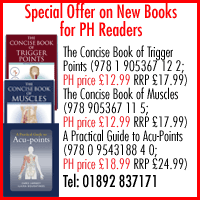Positive Health Online
Your Country

A Practical Guide to Acu-points
by Chris Jarmey and Ilaira Bouratinos
listed in acupuncture
There are now on the market a wide range of books in English about acupuncture points which use the same basic information which has been around a long time, essentially sourced from Chinese textbooks. Often the only difference between these books is the way the information is presented and the name of the author. This book is another addition to a long list of books about acupuncture points, but this time there is a significant difference. This book doesn't assume that the audience will only be acupuncturists. It is clearly written with therapists other than acupuncturists in mind, in particular shiatsu and massage practitioners. In addition, it is well laid out and unusually has much very practical information contained in the text.
The first thing to say in its favour is that overall it is a useful and practical book. It is undoubtedly a book that will primarily be of interest to students; also practitioners will also find it a useful clinical reference, especially as it is not as big and bulky as some books on the market. The information is easy to find and the book comfortable to handle.
The bulk of the text is devoted to describing the location, characteristics and functions of the main acupuncture points organised according to the channels on which they lie. There are some interesting short chapters at the beginning of the book dealing with needling, manual techniques, moxibustion, cupping and deqi. Most of this information is basic, common sense stuff, but no less useful and valuable for being so. It will reinforce what students should be learning in practical classes, and remind practitioners about what they should taking into consideration as they go about treating their patients.
The information about locating the points, the best position to place the patient, and needling the point, is both refreshingly clear and pertinent. It is followed by a description of manual techniques that can be used on the point, plus adjunctive therapies where appropriate, including moxibustion, magnets, guasha and cupping.
The diagrams are excellent, with the points clearly located in relation to adjacent points, muscles and bones. The diagrams are imaginatively presented and good use is made of colour to distinguish one anatomical feature from another. Clearly a lot of thought has gone into creatively illustrating the points in a way which mirrors the method of locating them, as well as the way in which they might be used therapeutically.
The layout is clear, there are distinctive titles and the demarcation between types of information is unambiguous. I liked the way the pages are colour coded according to the channels, a small but very practical consideration. The text is well written, with clear and uncluttered language.
Altogether, this makes for a pleasing presentation and gives one the feeling that the authors have genuinely thought carefully about how to present the information for the benefit of the reader; a rare quality. So often these considerations are left to editors and designers who have little concept of the need for practical usefulness in text books.
Although there is a list of source books at the end entitled 'Resources', none of the information is referenced. Some readers may consider this a small point not really worthy of mention. However, for the uninitiated student coming to the subject for the first time, the book asks them to take a lot on trust. With 25 years experience in practice, and almost as many years teaching and studying, I know that much of the information about the points contained in this book is standard information. You will find it in almost all good Chinese medicine textbooks. However, for others less knowledgeable, how can they trust the information if they don't know where it comes from. If it is the authors' experience, then say so; if it is from another text, put in a reference. This is particularly important with unusual information, which isn't common knowledge. Knowledge is power, it should be presented responsibly and with transparency, otherwise it smacks of arrogance. Too many books in complementary medicine field suffer from this.
In spite of this small tirade, I would recommend this book for all the positive reasons mentioned above. It will be a useful tool both in the classroom and the clinic.
Further Information
The book is available to PH readers for £18.99 including p & p; all orders should go to Combined Book Services, Units I/K, Paddock Wood Distribution Centre, Paddock Wood, Tonbridge, Kent, TN12 6UU. Tel.: 01892 837171; orders@combook.co.uk. All major credit cards accepted. Ref: PH/Acu-points. Offer closes 30th November 2008.
- Reviewer
- Geoff Wadlow
- Publisher
- Lotus Publishing and North Atlantic Books.
- Year
- 2008
- Format
- Softback
- Price
- 24.99
- Isbn
- 978 0 9543188 4 0 (Lotus) and 978 1 55432 696 3 (North Atlantic Books)
